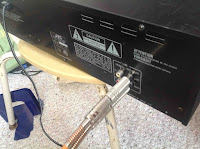On January 1, 1976, my sister recorded cassette tapes of our grandmother talking. We never understood much of Grandma’s language. She came to an isolated farm in Alberta in 1934 from Poland. She rarely left the farm, and never learned to speak English, or to read or write in any language. She spoke a mixture of her mother-tongue, which we assume was a dialect of Polish, splattered with a few English words. In my memory, her voice was powerful and entertaining, and I always hoped that one day I would understand more than instructions and farm chores; that I would know the deepest reaches of her thoughts and feelings.
My sister always said she had the tapes, but I’d never seen them. So when, one day, she showed up with a tape recorder and two tapes in tow, I was very happy. She asked me to make a copy. Having such unique recordings is a treasure. As the cassettes are now over 40 years old, their quality is deteriorating. I want to preserve them and use them, to listen to them, and translate what my grandmother was saying.
I decided to make a learning project out of preserving the content of the tapes, and to share the process here in case others with old cassettes stuck away somewhere and can learn from my experience. Who knows where a project like this could lead?
April 7, 2018 __Session 1 details:
Get help!
 I enlisted the help of my husband. He has recording equipment and experience. Although he had never done this kind of project before, he came to my rescue.
I enlisted the help of my husband. He has recording equipment and experience. Although he had never done this kind of project before, he came to my rescue.
Use a practice cassette first
If you’re not sure, get professional assistance.
Gather the equipment
· cassette player: you need a working cassette player with a line out
· audio interface (we used a Scarlett 18i8). This piece of equipment allows the analogue signal to be adjusted and converted to a digital signal as it is transferred to a computer
· digital audio workstation software (DAW) (we used Cubase for this project)
· cords, computer, speakers, headphones, blank cd’s, practice cassette and screwdrivers
Troubles with tapes and tape decks
Tip 1: Don’t throw away a working tape deck – your neighbour might need it one day. We tried four decks before we found one that was in good working order!
Tip 2: You don’t need to start listening at the beginning of the cassette, start anywhere. The more you rewind and fast-forward, the more you risk snapping the tape. Be careful about rewinding, especially right at the beginning or fast forwarding right to the end. If the tape breaks and slips away from reach, you might have to take the cassette apart to rethread it.
 Tip 3: If your tape breaks and you can see both ends, you can splice it with scotch tape. If your tape breaks and you can’t find the ends, you may have to open the case to join the ends and transfer it to another cassette if the cassette gets broken. Not all cassettes have screws, which was our problem. In that event, you may have to pry the body open with a screwdriver, being careful not to damage the tape, and transfer the tape to a new cassette frame. I know all this because it happened!
Tip 3: If your tape breaks and you can see both ends, you can splice it with scotch tape. If your tape breaks and you can’t find the ends, you may have to open the case to join the ends and transfer it to another cassette if the cassette gets broken. Not all cassettes have screws, which was our problem. In that event, you may have to pry the body open with a screwdriver, being careful not to damage the tape, and transfer the tape to a new cassette frame. I know all this because it happened!
Tip 4: Practice the transfer with a blank tape before you use the good one. I can't stress this enough! It’s a skill to learn how to move the roll from the broken cassette to the new one. Make sure you pay attention to the way the cassette gets put together as you take it apart.
Set up
Plug the cassette player into the audio interface (see photos)
Open software
In Cubase
1. Start a new project and configure it so that Cubase knows what’s going on.
2. Name the project
 3. Make sure that the signals are working: The left and a right channel must go through the audio interface, aka the analogue to digital converter
3. Make sure that the signals are working: The left and a right channel must go through the audio interface, aka the analogue to digital converter
4. Tell Cubase how to find where the signal is coming from
5. Play a bit and check the levels
6. Rewind the tape back to the beginning, carefully
7. Press record on the Cubase
8. Press play on the tape deck
After recording
Export the recording into a wave file
Burn the wave file onto a cd
Happy digitizing!
